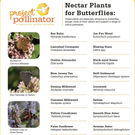
Gardening Resources
Ranging in size from a few containers to several acres, butterfly gardens can be grown throughout the United States. The general requirements for butterfly gardening are the same no matter where you live: nectar source plants, larval host plants, a pesticide-free environment and knowledge of the local pollinator fauna.
We're here to help you achieve the best pollinator garden!
Planning your garden
-
Plant your garden in as much sun as you can.
-
Full sun: 6-8 hours of direct sun daily
-
Part shade: 4-6 hours of direct sun daily
-
Shade: less than 4 hours of direct sun daily
-
-
Pollinator gardens are best planted in the spring with younger plants or in the fall with mature plants that will become dormant quickly and re-emerge in the spring.
-
Plant a variety of nectar sources that will encourage different species of butterflies.
-
Plant an adequate supply of host plants which gives butterflies a place to lay their eggs and result in butterflies that will continue to visit the garden.
-
A good resrource when planning your native garden is the Native Landscaping Manual developed by SNR in cooperation with the Missouri Department of Conservation, this can be found here

Attracting local pollinators
-
Butterflies are attracted to flowers with strong scents and bright colors where they drink sweet, energy-rich nectar.
-
Include host plants in your garden. Butterflies lay their eggs on host plants that the emerging caterpillars will eat.
-
Don't use chemical pesticides because they kill butterflies, caterpillars and other beneficial insects.
Click on the photos to the right to learn the best plants for attracting butterflies, host plants of specific butterflies, and how to identify beneficial pollinators like bees.












